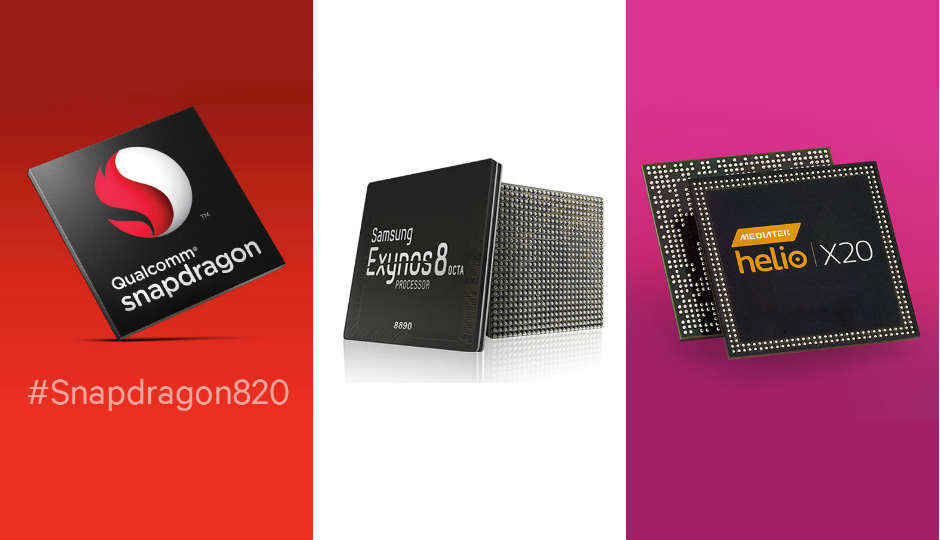All you need to know about the new flagship mobile SoCs of 2016
At MWC 2016 we are bound to see the new Snapdragon 820, Exynos 8890 and maybe the Mediatek Helio X20 but how do they stack up against each other? Here's a look.

MWC 2016, the biggest mobile launch event has just begun. Almost all major mobile manufacturers, with the exception of Apple, will be there to showcase their new and upcoming smartphones. Big companies such as Samsung and LG have already announced their new flagship devices, a day ahead of MWC. While these upcoming smartphones bring a slew of new features to the table, the major change will be is in the terms of performance. This upgrade in performance is achieved with the help of the latest flagship class SoCs. Now, there are only three major SoC makers at the moment which provide SoCs for the mobile market, but how do they stack up against each other? We take a look.
 Survey
SurveyFirst is Qualcomm. Almost all major phone makers are rumoured to come with at least one Snapdragon 820 powered phone. The recently announced LG G5 is running on the same. Second is Samsung which announced its Galaxy S7 and S7 Edge smartphone powered by the new Exynos 8890 SoC. This is an important SoC as down the year we may see other manufacturers using the same SoC on their upcoming products. And lastly, there is the Mediatek Helio X20 which is a beast, at least on paper, but we are yet to see any phones powered by this SoC. All three SoC’s have different architectures, will be offered in different smartphones but most importantly will churn out a flagship class performance. This is how they stack up:
| Qualcomm Snapdragon 820 | MediaTek Helio X20 | Exynos 8890 | |
| Mfg process | 14nm | 28nm | 14nm |
| CPU Cores | 2+2 cores | 4+4+2 cores | 4+4 cores |
| CPU clock speed | upto (2.2 + x) GHz | upto (2.5+2.0+1.4) GHz | upto (2.5 +2.2) GHz |
| GPU | Adreno 530 | Mali GPU | Mali-T880 |
| Max Display support | 3840 x 2160p | 2560 x 1600p | 4096 x 2160p |
| Video support | Up to 4K capture and playback | Up to 4K capture and playback | N/A |
| H.264 (AVC) | H.264 (AVC) | N/A | |
| H.265 (HEVC) | H.265 (HEVC) | N/A | |
| Camera support | upto 25MP | Dual ISP and upto 32MP | N/A |
| Connectivity | LTE Category 12/13 | LTE Category 6 | LTE Category 12/13 |
So, as you can see Qualcomm has gone with a quad-core setup and using its home made Kryo cores in the Snapdragon 820. As for Exynos 8890, Samsung has gone with a more traditional octa-core approach, but it is also using a new self-developed custom processor architecture which Samsung calls Mongoose cores. However, MediaTek is sticking with ARM based CPU cores, but on the Helio X 20, the core count has been increased. The new SoC has a deca-core setup. It is also worth noticing that the former two SoCs use a 14nm manufacturing process making them small and power-efficient. As for the Helio X20, it is using the same 28nm manufacturing process, but MediaTek claims that they have increased power efficiency by at least 20% compared to the Helio X10.
All these three SoC’s come with 4K video recording and playback support. The Helio X20 even supports dual camera ISPs and cameras upto 32MP. However, they differ in 4G support, as the Snapdragon 820 and Exynos 8890 support the latest LTE CAT 12/13 standards, the Helio X20 uses an older LTE CAT X6 standard.
It is quite evident that all these three SoC’s have there pros and cons but we are still short on information and real life analysis of which one of these SoC’s might be the better choice. Moreover, it will also depend on phone manufacturers who will be further optimising these chips to be used in their upcoming devices.
Hardik Singh
Light at the top, this odd looking creature lives under the heavy medication of video games. View Full Profile